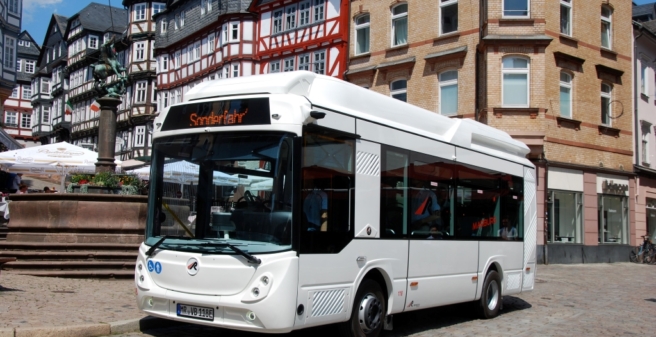
In Marburg, the beautiful university town, there are three bus routes, lines 10 (Hauptbahnhof – Oberstadt – Schloss), 16 (Alte Universität – Wehrshausen – Elnhausen – Dagobertshausen – Dilschhausen) and 20 (Behringwerke – Aquamar), which are served by midibuses. Particularly in the upper town, the narrow and sometimes steep streets would not allow any other buses, especially as there are hairpin bends to be negotiated that a “full-sized” bus could not manage.
Ever since the line to the castle was opened in the 1950s, the Marburg public utility company has always had special midibuses for these connections. It started with an Opel Blitz bus with a body by the well-known Essen coachbuilder Ludewig, there was a small Mercedes L 613 D with a body by Vetter, successively two midibuses by Setra, a Van Hool, small Neoplan and several small ones by Breda-Menarinibus. By the way, they all did what they were supposed to do. According to Stadtwerke managing director Otto, three of the Breda-Menarin buses are still in use today.
In 2021, the first battery-electric midibuses of the Italian manufacturer Rampini from Passignano in Tuscany followed. The two midi buses 86 and 96 of the type Rampini E 80 (E for electric bus, 80 for their length of 8 metres) were put into service. Bus 96 has covered 39,088 kilometres in the two years since then. Bus 96 has covered 39,088 kilometres in the two years since then, and bus 86 has covered 25,002 kilometres. Both buses are recharged via cable and CCS combo plugs during idle times at the “Am Krekel” depot.
On 11 July, Rampini now handed over two more electric midibuses to Stadtwerke Marburg. On this occasion, Dr. Bernhard Müller, Chairman of the Supervisory Board of Stadtwerke Marburg, said that the two previous coaches had proved themselves very well on the line to the castle through the upper town, and that they were excellently suited for this line.
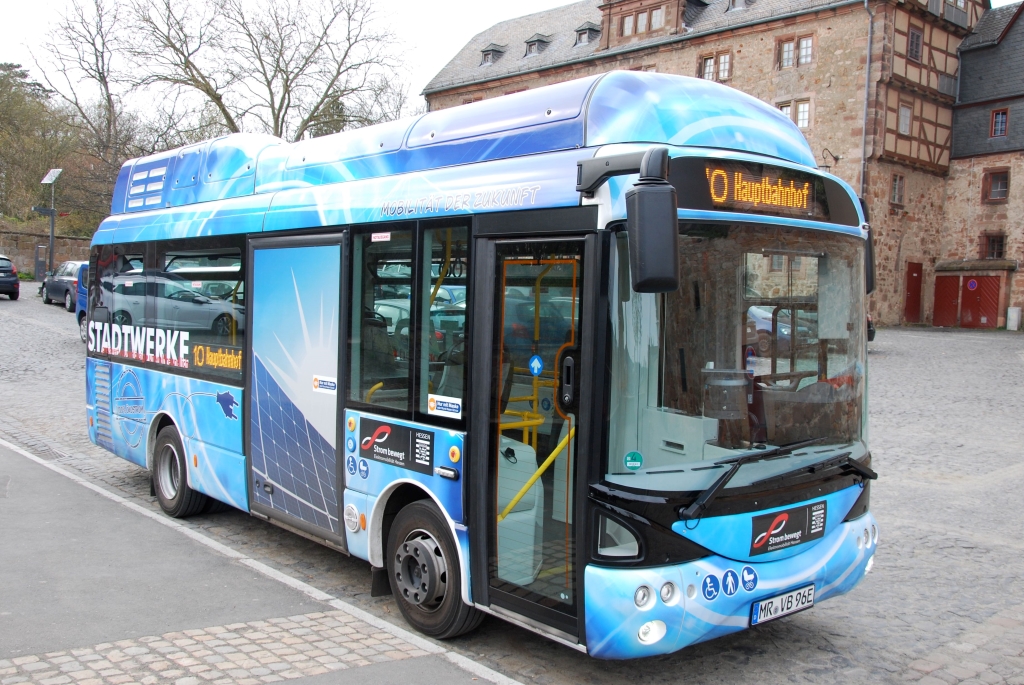
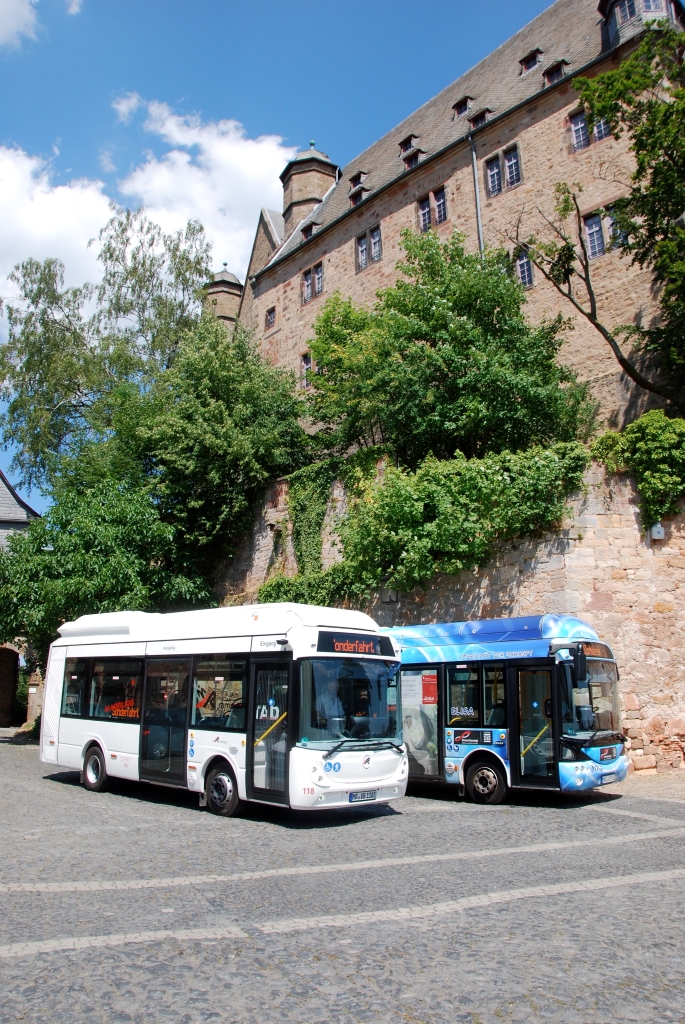
The two new Rampini are of the new type “Eltron”, the successor of the E 80. They are also 8,000 mm long and 2,200 mm wide. A demonstration run through the upper town to the castle showed that they should not be any wider either. In height they measure 3,250 mm, their wheelbase (distance from axle to axle) is 3,700 mm. At the front the bus has an overhang of 1,870 mm, at the rear 2,430 mm. The turning circle of only 14,850 mm is remarkable – although it is still too large at the final stop at the top of the castle, where it is actually necessary to reverse. For which, of course, the buses have a reversing camera – after all, the driver has to know what is going on behind his bus. The allowed max. total weight of the bus is 12,000 kg.
Speaking of cameras, you won’t find any rear-view mirrors on the new Rampini. Instead, “mirror eye cameras” provide a view to the rear. On the way through the upper city, it became apparent that conventional rear-view mirrors would have been “shaved off” more than once. In addition, mirror eye cameras offer a larger image section and thus a better view behind the bus than conventional mirrors.
Propulsion of the electric midibuses in Marburg
The bus is propelled by the TM 4 central motor from the US manufacturer DANA, a highly efficient permanent magnet synchronous motor with three phases that operates continuously at up to 7,000 revolutions per minute. The peak power of the engine is 235 kW (320 hp), the continuous power 133 kW (180 hp). During braking, the engine recuperates power, which takes place in three stages. A lever on the steering wheel can be used to initiate the recuperation of electricity.
The top speed of the two Eltron is 75 km/h. The vehicle can cope with gradients of 16 % – which does not happen in Marburg’s upper town, despite the steep streets.
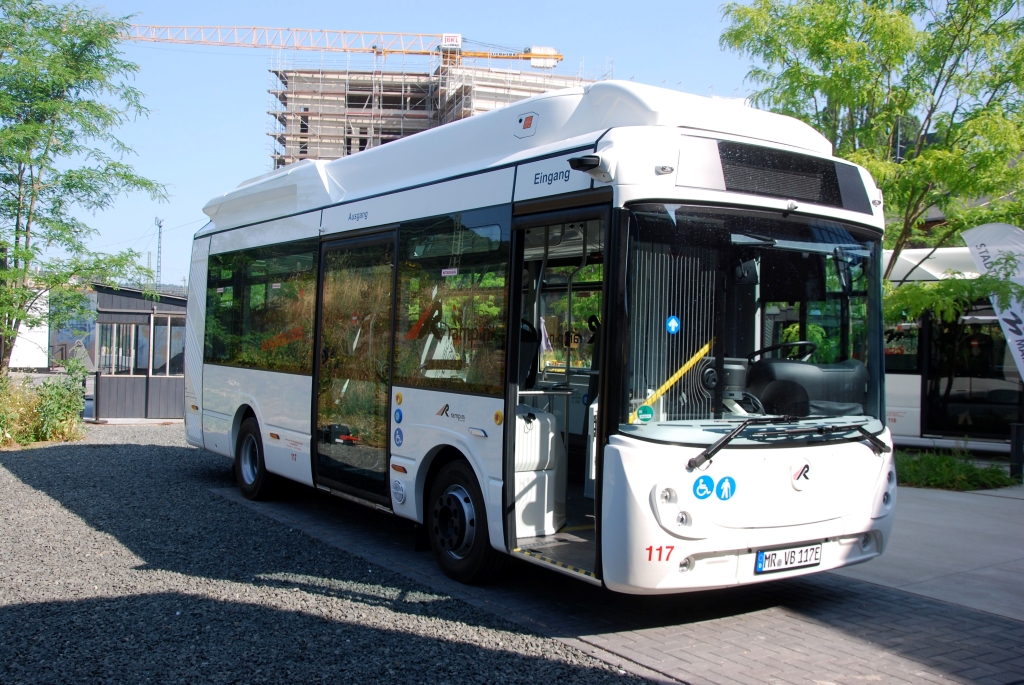
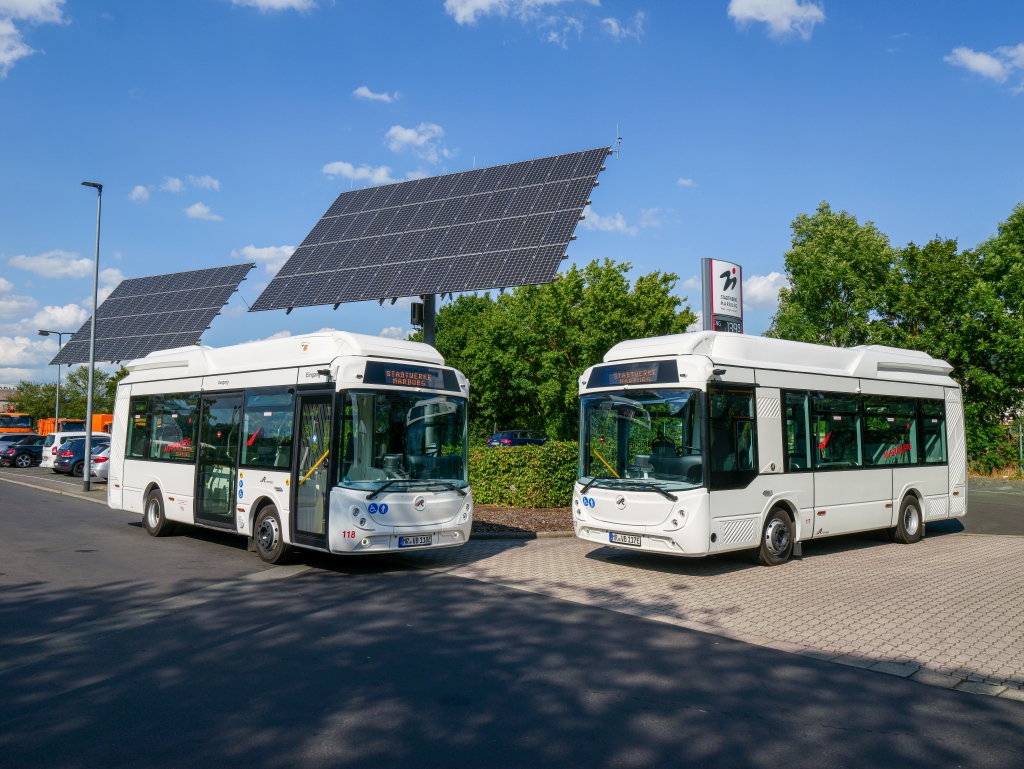
Recharging of the midibuses
Like their older brothers, the two new Rampini are recharged at the depot via cable and CCS combo plug. If they are charged with 22 kilowatts direct current, it takes ten hours to completely fill up the batteries, with 40 kilowatts it takes five hours and 40 minutes, and a fast charge with up to 120 kilowatts direct current takes two hours.
However, the municipal utilities want to introduce a completely different recharging technology: via a pantograph mounted on the roof. via a pantograph mounted on the roof. For this, they are planning with Schunk from Heuchelheim in Hesse. The bus drives under its charging station at the depot, the driver presses a button, the pantograph rises to the charging station and the bus is recharged. With the push of a button, the driver has done everything that needs to be done for the recharge and can therefore go home without worrying.
The batteries
The lithium iron phosphate (LiFePh) batteries from the Chinese manufacturer CATL have found their place in eight modules on the roof of the bus. They have a capacity of 281 kW. (If a pantograph is mounted on the roof, the number of battery modules will be reduced to six and the capacity thus to 210 kW). Rampini gives the range of the two Marburg Eltron as more than 300 kilometres, provided the air conditioning and heating are not running.
On line 16, which has a daily mileage of 500 kilometres, the bus must therefore be replaced once a day, because recharging on the line is not planned. The other two lines, 10 and 20, manage with the range of the batteries.
The equipment of the buses
The two new Rampini Eltron can busry 48 passengers, 14 of whom have a seat and 34 a standing place. The seats are made by the German manufacturer Kiel. A wheelchair can be taken along, for which there is a manually fold-out ramp at the wide middle door.
The two new small Marburgs are two-door vehicles. They have a single-width interior swing door at the front and a double-width, but one-piece swing-sliding door in the middle of the bus. The public utility company has opted for doors from a Dutch manufacturer.
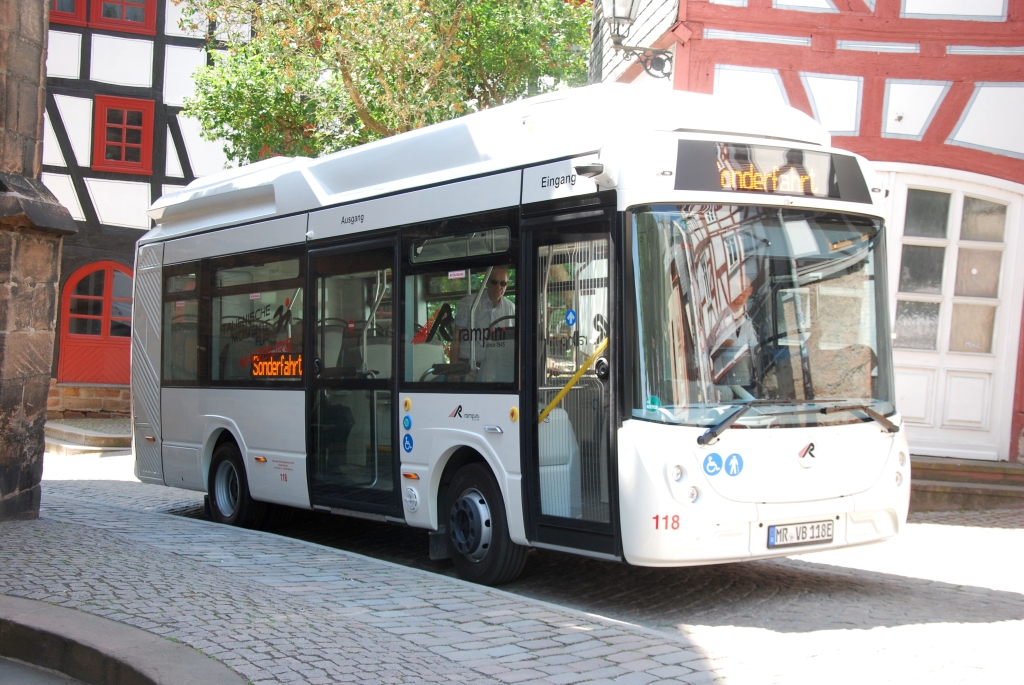
Rampini’s programme
In addition to the “Eltron” now delivered to Marburg, Rampini’s product range currently also includes the “Sixtron”. Like the “Eltron”, this is an electric midibus, but it is only 6,000 mm (6 metres) long. It also has a predecessor in the form of the Rampini E 60, and it too – with the new generation – has been given a significantly modernised outfit. Which Rampini calls “Stile Energetico”.
For the first time, Rampini will exhibit at the world’s largest pure bus trade fair “Busworld” in Brussels in October, and not only “Sixtron” and “Eltron”. Rampini’s brand-new, eight-metre-long hydrogen bus “Hydron” will also celebrate its world premiere at the stand.
In the discussion about the hydrogen bus Hydron, the question came up whether hydrogen makes sense at all to power buses. Rampini’s answer, however, was more than clear: “But of course we need hydrogen buses.” If you want to drive electrically in the countryside, there is no way around the hydrogen bus. It is not possible to build charging stations everywhere in “the countryside”, and the electric infrastructure in remote areas is often not sufficient to provide a recharging station for electric buses with sufficient capacity. “So what would be the alternative? Should we continue to use diesel buses after all?”
Rampini is determined to position itself internationally. A new management division, “International Sales”, has been created. An Italian who worked for four years in the management of BMW in Munich has been appointed head of the department. Four years in Germany? The good man speaks excellent, almost accent-free German. The author asked him about it. His reaction: “With my Bavarian, you wouldn’t be able to keep up. The author, Rhinelander that he is, believed it unquestioningly – he has never lived in Munich for four years – and therefore dispensed with the proof of truth.
La storia Rampini – the history of Rampini
In 1945, Buslo Rampini and Fernanda Pepini founded “Rampini Buslo SpA” (German: Rampini Buslo AG). Initially, the young company was involved in the repair and maintenance of existing vehicles – there was plenty to do so shortly after the Second World War. In the fifties and sixties, the product portfolio was expanded to include the development and construction of special vehicles.
As early as the seventies and eighties, the construction of fire-fighting and airport vehicles is added. In the eighties and nineties, the construction of special vehicles for the military also begins.
2000 marks the beginning of a completely new phase in the company’s history: Rampini starts building electric vehicles, for example electrically powered rubbish trucks. The company also starts building electric and hybrid buses. Rampini takes over the “Alé” midibus from “Autodromo” – Busozzeria Autodromo Modena (CAM). At one time MAN wanted to launch its own “Alé” midibus, and at the IAA 1998 and 2000 a “MAN Alé” was on display at the Frankfurt trade fair. The vehicle combined proven MAN technology such as engine, transmission and axles with the smart Italian styling of the Autodromo body.
Rampini now turned the “Alé” into an electric bus, with which they are quite successful, especially in Italy. Together with Dr. Caterina Rampini from the Rampini board, the author calculated at the presentation in Marburg that there are currently eleven Rampini in Germany, four of them in Marburg alone, two each in Hamburg and Regensburg. Dottoressa Rampini: “In Vienna alone there are twelve. And Vienna has ordered considerably more new trolleys from us.”
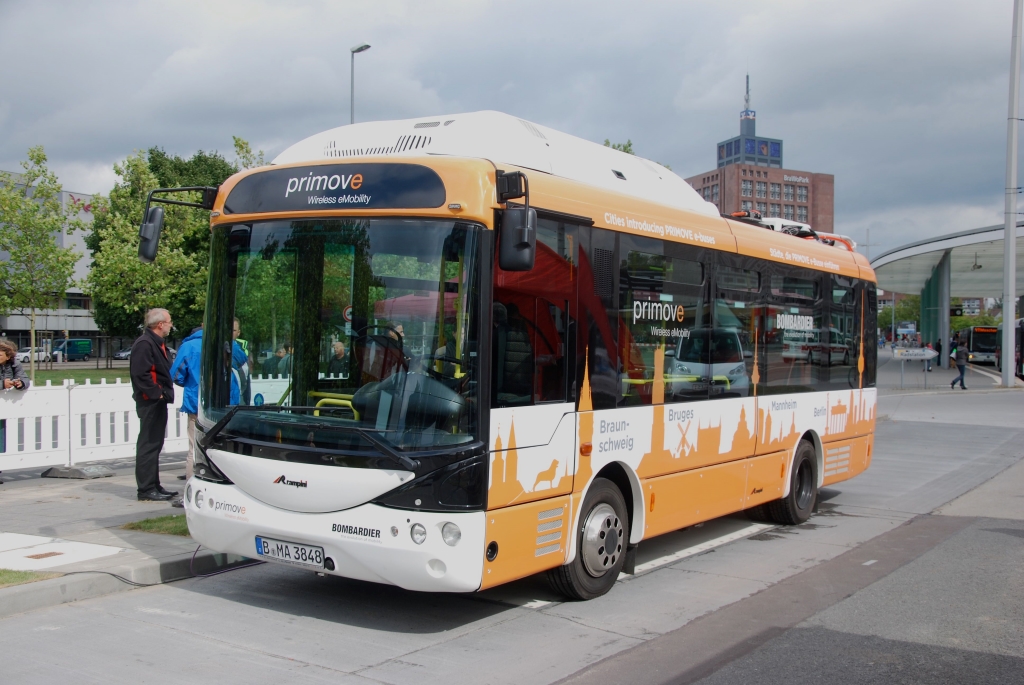
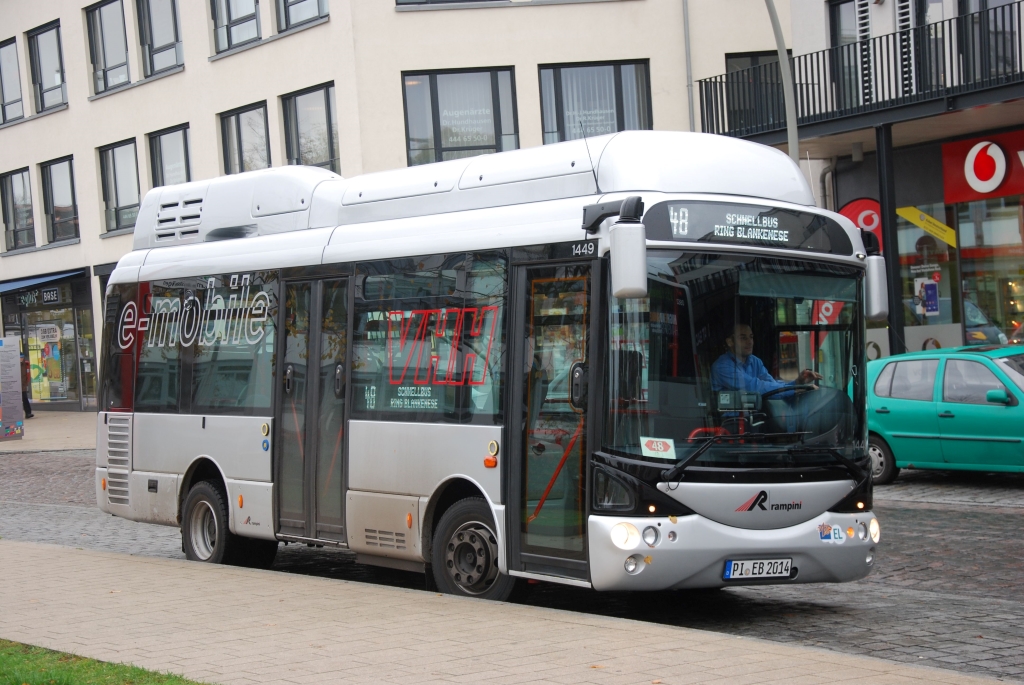
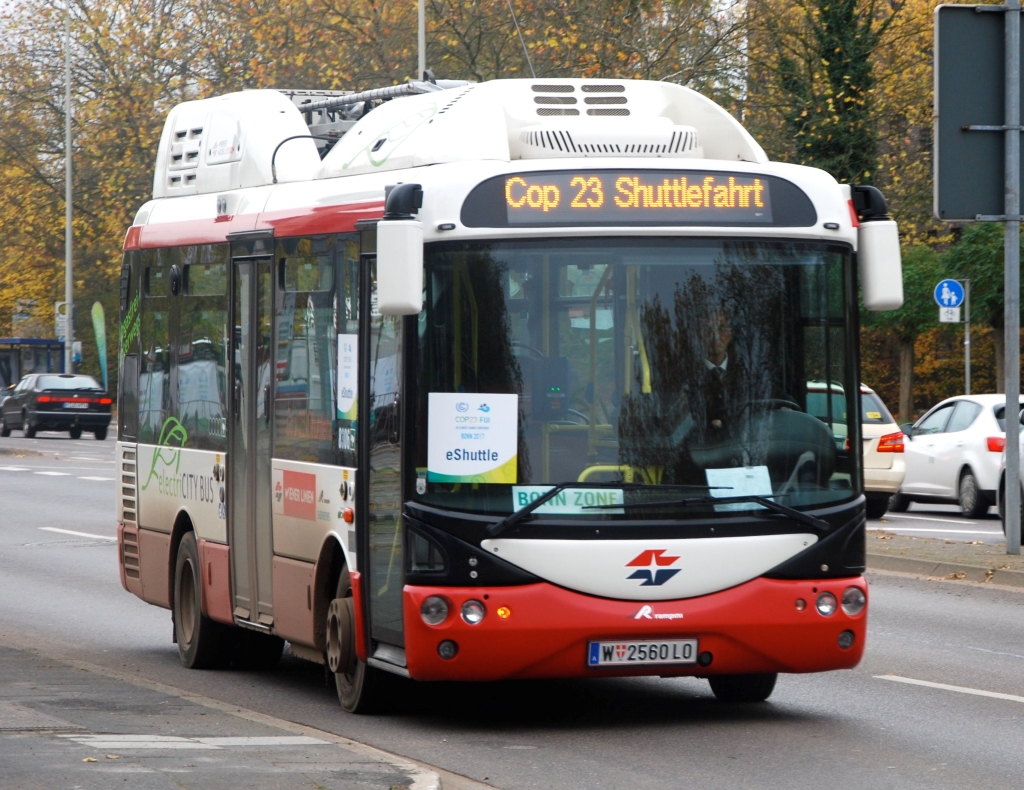
About the plans of the Marburg public transport operator
Marburg plans to convert all bus services to electric operation by 2030. Another Rampini and the first 12-metre-long electric solo buses are to be put into service around the turn of the year. Diesel buses are to be used only in school bus and similar services after 2030.
The author asked Managing Director Otto about SWM’s two trailer trains. His response: “If we could, as we would like to, we would abolish the trailers and let the two towing vehicles (both MAN) run as solo vehicles in our network. As it is, however, we have to use the two trailer trains like articulated buses.”
And regarding plans to convert both lines 5 and 7 to operation with in-motion chargers (battery trolleybuses): “This would require spanning both lines from the Lahn Valley up the Lahn Mountains with a trolleybus contact line. However, there is now resistance to such plans. With the following justification: “Battery technology is making such enormous progress that recharging on the line will soon no longer be necessary. Nevertheless, they feel they have to think about it, because “soon we will have over 100 buses.”
Marburg wants – how could it not – to convert all scheduled services to electric buses by 2030. To this end, another Rampini and the first 12-metre-long electric solo buses are to be put into service around the turn of the year. Diesel buses are to be used only in school bus and similar services from 2030.
The author asked Managing Director Otto about SWM’s two trailer trains. His response: “If we could, as we would like to, we would abolish the trailers and let the two towing vehicles (both MAN) run as solo vehicles in our network. As it is, however, we have to use the two trailer trains like articulated buses.”
Regarding plans to convert both lines 5 and 7 to operation with in-motion chargers (battery trolleybuses): “This would require spanning both lines from the Lahn Valley up the Lahn Mountains with a trolleybus contact line. However, there is now resistance to such plans. With the following justification: “Battery technology is making such enormous progress that recharging on the line will soon no longer be necessary.” Let’s see what the future brings in Marburg.
18.07.2023
